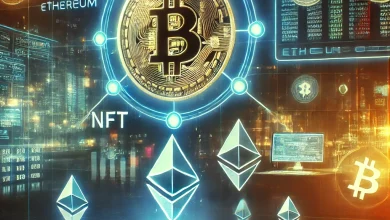Exploring Decentralized Finance (DeFi): Opportunities and Risks
Exploring Decentralized Finance (DeFi): Opportunities and Risks
Introduction
Decentralized Finance (DeFi) is revolutionizing the financial industry by providing open, permissionless, and blockchain-based financial services without traditional banks or intermediaries. This innovation allows users to borrow, lend, trade, and earn interest on digital assets in a decentralized ecosystem.
However, while DeFi presents numerous opportunities, it also comes with risks that investors must understand before diving in. This article explores the key benefits, use cases, and potential risks of DeFi, helping you make informed financial decisions.
What is Decentralized Finance (DeFi)?
Decentralized Finance (DeFi) refers to a collection of financial applications built on blockchain technology, primarily on Ethereum and other smart contract platforms. Unlike traditional banking, DeFi operates without central authorities, allowing for greater transparency, accessibility, and efficiency.
Key Features of DeFi:
✅ Permissionless Access – Anyone with an internet connection can participate.
✅ Smart Contracts – Automated, self-executing contracts ensure secure transactions.
✅ Interoperability – DeFi applications can connect and interact seamlessly.
✅ Transparency – Transactions are recorded on a public blockchain, reducing fraud.
Popular DeFi platforms include Uniswap, Aave, MakerDAO, Compound, and Curve Finance.
Top Opportunities in DeFi
1. Decentralized Lending & Borrowing
DeFi allows users to lend and borrow crypto assets without traditional banks. Platforms like Aave and Compound provide liquidity pools where lenders earn interest and borrowers secure loans using crypto as collateral.
🔹 Key Benefits:
- Higher interest rates compared to traditional savings accounts.
- Instant borrowing without credit checks.
- Lower fees and faster transactions.
2. Yield Farming & Liquidity Mining
Yield farming enables investors to earn passive income by providing liquidity to DeFi protocols. Users deposit crypto assets into liquidity pools and receive rewards, often in the form of governance tokens.
🔹 Popular Platforms: Uniswap, PancakeSwap, Curve Finance
🔹 Potential ROI: Some yield farmers earn double-digit annual returns.
3. Decentralized Exchanges (DEXs)
DEXs allow users to trade cryptocurrencies without intermediaries. Unlike centralized exchanges like Binance or Coinbase, DEXs eliminate the need for a third party to hold funds.
🔹 Advantages of DEXs:
- No KYC (Know Your Customer) requirements.
- Users maintain full control of their funds.
- Lower risk of exchange hacks.
4. Stablecoins & DeFi Payments
Stablecoins like DAI, USDC, and USDT provide price stability in DeFi. These digital assets are pegged to fiat currencies, allowing for secure transactions and remittances.
🔹 Use Cases:
- Cross-border payments without high bank fees.
- Hedging against volatility in crypto markets.
5. DeFi Insurance & Risk Mitigation
Insurance protocols like Nexus Mutual and Cover Protocol offer coverage against smart contract failures, hacks, and asset losses.
🔹 Why It’s Important:
- Protects investors from DeFi security breaches.
- Reduces the risk of losing funds due to protocol failures.
Major Risks of DeFi Investments
While DeFi presents exciting opportunities, it also comes with potential dangers. Investors should be aware of the following risks before entering the market.
1. Smart Contract Vulnerabilities
DeFi platforms rely on smart contracts, which can contain coding errors or security flaws. Exploits have led to multi-million-dollar hacks, such as the $120M BadgerDAO hack and the $600M Poly Network attack.
🔹 How to Mitigate:
- Only use audited and reputable DeFi platforms.
- Diversify investments across multiple protocols.
2. Impermanent Loss in Liquidity Pools
Liquidity providers on platforms like Uniswap and SushiSwap may experience impermanent loss when asset prices fluctuate significantly.
🔹 How to Reduce Risk:
- Choose stablecoin pairs (e.g., USDT/DAI) to minimize volatility.
- Understand the risks before providing liquidity.
3. Regulatory Uncertainty
Governments worldwide are still developing regulations for DeFi, and future policies could impact investments. Countries like China have cracked down on DeFi and crypto, while the U.S. SEC is exploring DeFi regulations.
🔹 What to Watch For:
- Potential KYC and AML (Anti-Money Laundering) laws affecting DeFi platforms.
- Tax implications for DeFi earnings and staking rewards.
4. Rug Pulls & Scams
Many DeFi projects are anonymous, increasing the risk of scams where developers abandon projects and steal investor funds.
🔹 How to Protect Yourself:
- Research projects thoroughly (check audits, team transparency, and roadmaps).
- Avoid high-risk, high-reward “meme” tokens.
5. High Gas Fees
Ethereum-based DeFi transactions can be costly due to high gas fees. Alternatives like Solana, Polygon, and Binance Smart Chain (BSC) offer lower transaction costs.
🔹 Ways to Save on Gas Fees:
- Use Layer-2 solutions (e.g., Arbitrum, Optimism).
- Trade on low-fee blockchains like Avalanche or Polygon.
How to Get Started with DeFi
1. Choose a Secure Crypto Wallet
Use non-custodial wallets like MetaMask, Trust Wallet, or Ledger to store and manage your DeFi assets.
2. Select a DeFi Platform
Start with reputable DeFi platforms such as:
🔹 Lending: Aave, Compound
🔹 Trading: Uniswap, SushiSwap
🔹 Yield Farming: Yearn Finance, Curve
3. Perform Due Diligence
Before investing in any DeFi project, research:
✅ Audit reports (Check platforms like CertiK or Hacken).
✅ TVL (Total Value Locked) – Higher TVL indicates stronger trust.
✅ Community feedback – Join Reddit, Discord, and Telegram groups.
4. Start Small & Diversify
Invest only what you can afford to lose and spread your investments across different DeFi applications and blockchains.
Conclusion: Is DeFi Worth the Investment?
✅ YES – If you understand the risks and opportunities.
Decentralized Finance is disrupting traditional finance, offering investors new ways to earn and manage wealth. However, like any investment, it requires research, risk management, and careful strategy.
📌 Final Tips:
- Stay updated on DeFi trends and regulations.
- Use secure wallets and reputable platforms.
- Be cautious of hacks, scams, and market volatility.
🚀 What are your thoughts on DeFi? Let us know in the comments!
📩 Subscribe to Tech Financial Idea for more insights on finance and technology!



